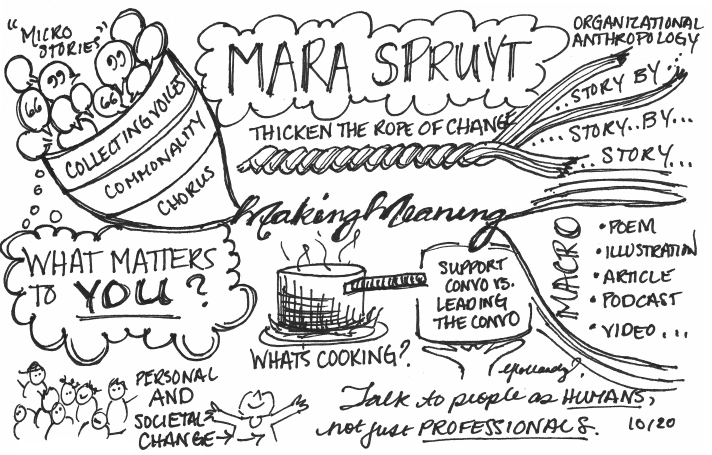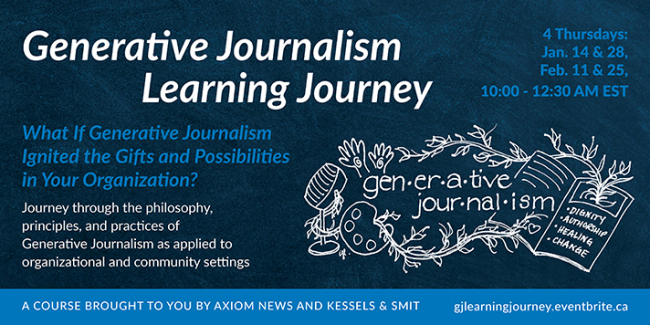
Illustration by Yvonne Hollandy.
The conversations we have, the stories we collect, one by one, thicken the rope we walk on into the future, says Mara Spruyt, organizational journalist with Kessels and Smit.
In Appreciative Inquiry it is often said that change happens one conversation, one story, at a time.
“Let’s not forget that’s how it works,” says Mara.
For Mara, that’s what generative, organizational journalism (GOJO) is about, sharing one story at a time to bring about change in our lives and organizations.
“People work in organizations and organizations are part of society. So, what we do has an impact on society.”
| “I’m convinced of the importance of thick micro-stories.” | |
To that end, the more personal a story is the more it contributes to a macro story. You might think that a more personal story, a particular story, is harder to relate to, but it’s not. The more personal a story is, the more it can actually touch others, the more they can relate to it with their own experience.
“I’m convinced of the importance of thick micro-stories,” Mara says.
Mara begins by asking people in the organizations she works with to identify who has an interesting perspective that should be heard. By noticing someone, appreciating someone, and then inviting them to share their perspective, this begins the story-telling journey on an appreciative foot.
People will feel seen and heard before you even ask a question.
Having begun with an appreciative invitation Mara poses questions like:
- What’s cooking?
- Why is that important to you?
- Looking to the near future, what is it that you would do differently or new?
- Looking back, what would you want to be the same or what would you do the same?
- What would you like add to what is happening?
- What is it that you appreciate and think should be continued?
Generative Journalism is first about being curious, asking questions, and the whole toolkit of journalists. Second, it’s about form. In journalism, there’s a lot of focus on the product, on the form. The form could be a written word story, magazine, video, or a podcast. This differentiates Generative Journalism from other forms of narrative work, it produces and publishes media. Form makes a story concrete, tangible.
“And for me, that can also be a poem. I know that poets don’t consider themselves journalists. Poems are one of the forms that I use. We have podcasts. We have magazines. The form you choose is important in order to learn what’s cooking,” Mara says.
Thinking in form is helpful and meaningful and can change the lens a journalist looks through too.
“I put something different on when I have to make a poem. It’s a different lens, a different ear than when I make a podcast or when I make a magazine. If you’re going to write a poem, you have a different type of attention for what’s cooking. You’re really looking at what is cooking underneath, like under the water surface,” Mara says.
If you make a magazine, what’s cooking becomes about learning from different voices, a collection of stories.
Mara says stories can bring about change on a personal level and on a societal level. It’s not necessarily something new, but there’s a lot of work to be done in a world that we can contribute to with our experience and our knowledge, as generative, organizational journalists.
“This narrative work has impact because we talk to people as human beings, not only as professionals,” Mary says.
Acknowledgment for the work is needed so it can be more widely practiced.
Story by story we thicken the rope we walk upon into the future.
“Let’s not forget that’s how it works.”
In this podcast Mara tells the story of her journey to generative, organizational journalism. This article is a weaving of some the insights shared during our conversation.
Listen to this and other Axiom News Podcasts on Spotify.
To learn more about Generative Journalism visit the Journalism for Change podcast. Also check out the September 2020 edition of the Appreciative Inquiry Practitioner.
Upcoming Event






